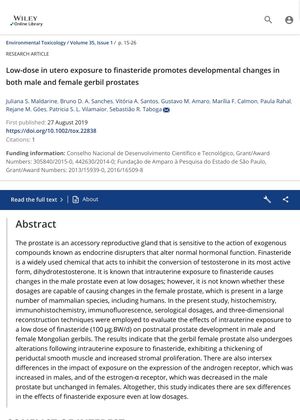Low-Dose In Utero Exposure to Finasteride Promotes Developmental Changes in Both Male and Female Gerbil Prostates
August 2019
in “
Environmental Toxicology
”

TLDR Exposure to low doses of finasteride in the womb causes changes in the prostate of both male and female gerbils.
The study conducted by researchers from the State University of Campinas and São Paulo State University in Brazil in 2019 investigated the effects of low-dose intrauterine exposure to finasteride on postnatal prostate development in male and female Mongolian gerbils. The study found that even at low dosages, finasteride exposure led to changes in both male and female prostates. In female gerbils, it caused a thickening of periductal smooth muscle and increased stromal proliferation. The study also found sex differences in the impact of exposure on the expression of the androgen receptor, which was increased in males, and of the estrogen-α receptor, which was decreased in the male prostate but unchanged in females.











